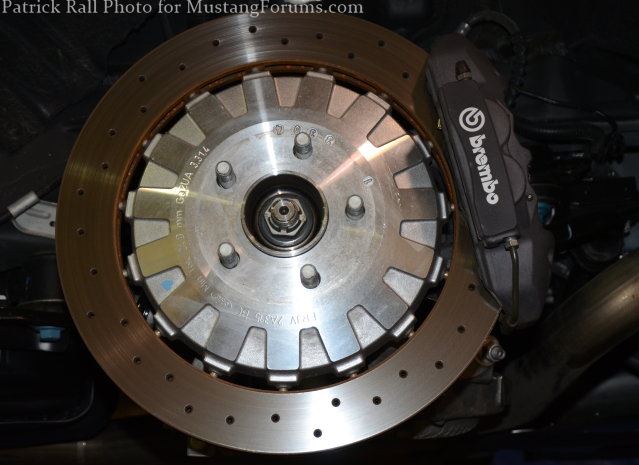Details on the Suspension and Brakes of the New Shelby GT350 Mustang
Yesterday, I spent some time at the Ford Performance headquarters in Allen Park, Michigan, where the 2015/2016 Shelby GT350 Mustang engineers showed me the suspension and braking components that will help make the car the best-handling Mustang of all time – and maybe the best-handling American muscle car of all time.
Of course, that second part is speculation, but given what the Ford team has said about the new Shelby GT350, it should offer better road-course performance than any generation in the 50-year history of the original pony car.
The 2015/2016 Ford Shelby GT350 Mustang has a host of features that make it more track-capable than the 2015 Mustang GT. Those include a collection of weight-saving items, the new V8 engine with the flat-plane crank, and the most elaborate cooling system to ever come on a stock Mustang.
However, the components that will possibly help the new GT350 become the best-handling muscle car of all time are found predominantly in the suspension and braking systems, where Ford has introduced its new MagneRide setup and one of the most intricate braking systems ever to come on an American muscle car from the factory, respectively.
Suspension
Ford will introduce its first magnetic ride control system on the GT350. With the help of a wide variety of sensors in and around the car, this suspension setup will allow for a comfortable ride in street mode and offer the stiffness and responsiveness needed for track duties.
The suspension upgrades on the new Shelby Mustang go far beyond its high-tech adjustable dampers, though.
First, the front steering knuckles (one is shown above, right) of the GT350 Mustang are made from lightweight aluminum and feature unique mounting points for the various suspension components. In addition to saving weight, these knuckles allow the new Mustang to comfortably wear 295-series front tires in GT350 guise and 305 fronts in GT350R trim – both of which are wider than any front tire ever offered on a factory Ford Mustang.
Next, the 2015 Shelby GT350 has a lower rear control arm setup (above, left) that’s similar to what’s found on the rest of the new Mustangs with independent rear suspensions. However, for the Shelby, the lower control arms have been set up to carry reverse-twisted rear coil springs (below).
Finally, the Shelby GT350 Mustang will have a chassis that is both lighter and stiffer than that of the Mustang GT, which, when combined with the high-tech suspension setup, will likely make good on those “best-handling” statements.
Brakes
While the 2015/2016 Shelby GT350 Mustang has a suspension system that is more capable than any other in the 50 years of the fabled pony car, Ford’s engineers were quick to point out that the most important aspect of this car is its intricate braking system.
Unlike so many high-end performance cars that have gone with costly carbon-ceramic brakes, the new GT350 has a more traditional – yet extremely unique – two-piece steel and aluminum brake rotor design.
It features 15.5-inch rotors up front and 15-inch rotors out back, but the most impressive aspect of these discs isn’t their size. It’s their construction. Unlike a normal two-piece rotor, whose steel braking surface is affixed directly to the central hat, the GT350’s braking surface rides on a set of pins mounted around the outside of the lightweight aluminum center hat.
This pin system allows the rotors to expand when they get extremely hot. As a result, they’ll provide more consistently flat braking surfaces. The pin system also helps keep some of the heat of the braking surface out of the central hat and that keeps the wheel bearings cooler, thus preventing rapid wear of them during a race.
These high-tech rotors are unlike anything ever offered on an American production vehicle. Although Ford stated that some very premium cars from overseas use these brakes, my Google search didn’t reveal any vehicles equipped with the pinned rotor design.
Ford wanted to do its best to keep the rotors cool under the rigors of road racing, so the venting fins between the braking surfaces are curled forward, creating a scoop design that pulls more air through the rotors while cool air streams into the wheel well through the vents in the front fascia.
Clamping down on these huge discs is a set of six-piston Brembo calipers up front that are fixed to the steering knuckle for more positive braking pressure at all times. Four-piston Brembo calipers at the rear end use a more traditional floating fixture design. However, the rear rotors still sport the pin design.
At this point, we don’t know for sure how much power the new 5.2L flat-plane V8 will offer, but it should deliver at least 500 horsepower and more than 400 lb.-ft. of torque. Along with that output, the new advanced braking and suspension package should give the 2015/2016 Shelby GT350 Mustang a very good chance of being the best handling muscle car – ever.
Chime in with your thoughts on the forum. >>
Looking for a good deal on a new Mustang? Get insider information here.










